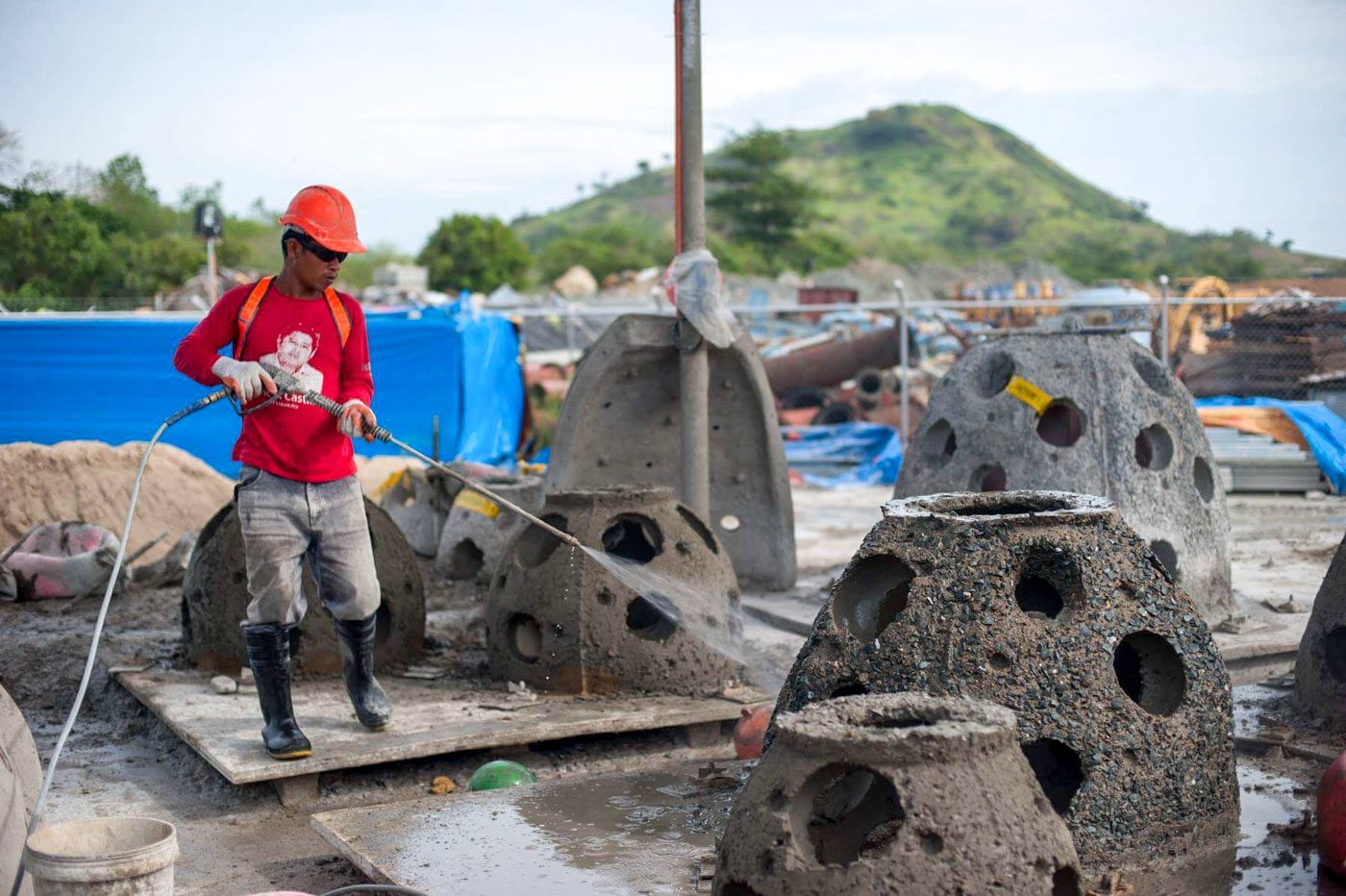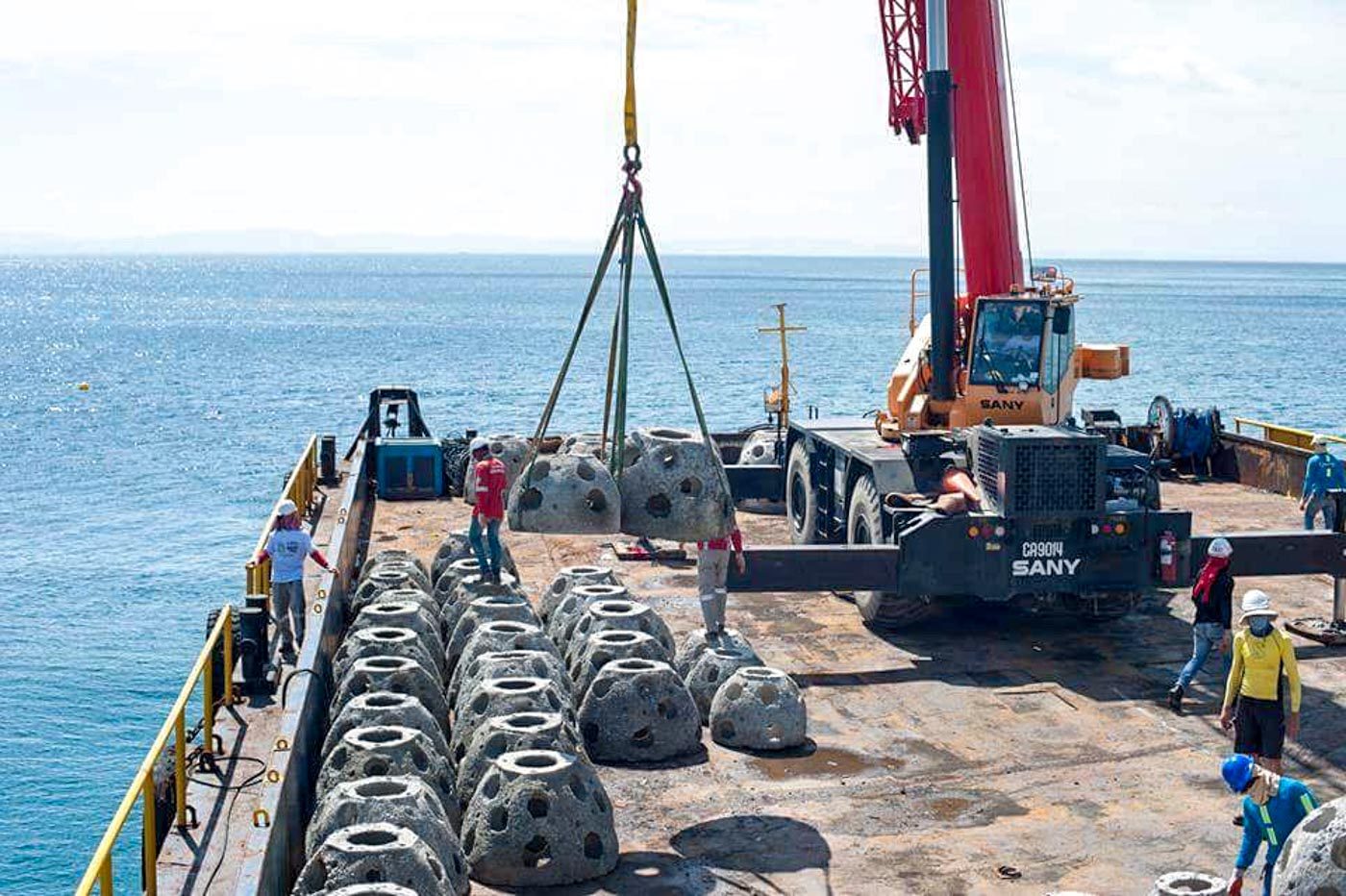SUMMARY
This is AI generated summarization, which may have errors. For context, always refer to the full article.

MASBATE, Philippines – The waters of Port Barrera off the shores of Tigbao village in Masbate was very still and clear that July. But still wasn’t a good term for what was once a lush coral garden. Decades of dynamite fishing, cyanide fishing, and overfishing took its toll on the waters of Masbate. The Department of Environment and Natural Resources assessed that Port Barrera has only 12 percent of its original living coral cover.
But the stillness of the water was punctuated by the splashing as reef balls were being thrown by crane or forklift aboard the barge of the Filminera Resources Corporation. Divers at the waters were there to upend the reef balls at the ocean floor.
Reef balls look more like the bullet head rather than a ball, with holes on top and on the sides. Their gray, rough texture reminds one of the stupas of Borobudur, especially the bigger ones. Filminera was dispatching about 300 reef balls in different sizes at the Colorada Marine Protected Area (CMPA) in the 129 hectares of Aroroy, Masbate. More than 100 were initially brought in last December. Filminera plans to dispatch 1,000 reef balls here.
This is not just the mining company’s commitment to its host community. Environment Secretary Roy Cimatu, who came here last June, said that he wants to monitor the success of the reef balls here so he can replicate it to other endangered coral reefs in the country. In fact, there were about four divers from Boracay who were training here in Port Barrera so they can eventually do the same in Boracay next year.
It was Masbate Gold Project (of which Filminera is the main partner) Environmental Advisor Damien Tredwell who introduced the Reef Ball artificial reef technology to hasten the coral regeneration in CMPA. These artificial reef modules are designed to mimic natural reefs, with a shape that can withstand strong waves, a rough texture for coral to settle in, huge holes to create whirlpools to circulate nutrients within and around the ball and smaller plugs to attach the corals.

Last year, Andrew Myers, a member of the Reef Ball Foundation, came here not only to bring the reef balls into the waters of Aroroy but also to teach the residents how to make them.
Most of the materials were sourced locally, Myers said, except for a special cement to lower the PH of the structure and similar to that of seawater.
He said that the balls can last up to 500 years. They can also withstand strong typhoons because the opening in the top of the unit breaks up the lifting force of the hydrofoil effect common to dome shapes. The side holes also recreate miniature vortexes which further reduce lifting forces and bring nutrients to life on the reef.
“They are so enticing that after only a few minutes, you would see fish already scouting the reef balls and probably saying, ‘this is going to be my home’,” Myers said.
Twelve residents from Tigbao were hired and taught by Myers to make Reef Balls inside the MGP compound. Rommel Cabiltes, 39, said that he was once a dynamite fisher but has since mended his ways. The first job in the morning for the reef ball makers is to take off the reef balls they made the previous day from the fiberglass molds. After that, they would mix the cement for the next molding. They usually do about six to seven reef balls every day ranging for the five-foot-tall Ultra to the two-foot LoPro. The other reef balls they make are minibay, bay ball, pallet, and mini-ultra.
“If the orders from Boracay and other places would come in, we would be ready,” said Cabiltes.
The reef balls are rough-textured so they can be easily inhabited by seaweeds and corals. “But you can’t wait for ten to 15 years of natural coral recruitment,” said Lovelle Cariaga, the senior environmental officer for MGP. “You have to make “corals of opportunities”,” she said.
The reef balls have plugs where Cariaga and other divers would later “plant” pieces of living coral fragments or larval corals.
Cariaga said that they also coordinated with the academe in using “corals of opportunities” reared in coral nursery units for 6 months and then “out-planted” on the balls. She said that a one-centimeter growth per month and 80 percent survival rate were achieved with this technology.
The mining company expects to propagate 10,000 coral reefs with this technology this year alone. But then, Cariaga said that this would not be sustained without community effort.
Reef restoration scientists said that there were three waves leading to this realization.
The first wave, which started in the 1970s, had coral transplants or artificial constructs like old ships, concrete pipes and disposed tires. The second wave from 2000 to 2010 had scientists and conservationists selecting species to propagate, leaving out invasive species like crown-of-thorn starfish and lionfish. The third wave, from 2016, focused on new scientific technology such as micro-fragmentation or the breaking coral into small pieces so it grows faster as well as the emphasis on the community to reduce threats and restore reefs.
For MGP, it meant creating the Colorada Marine Protected Area last year. Cariaga said that the residents were trained on the do’s and dont’s within the protected area including the prohibition of fishing, blasting, anchoring, collecting of seaweeds, seagrass and corals and bathing within the zone.
The residents were taught to be vigilant in protecting the CMPA so they can harvest on its gains later.
Darwin Regala, 34, was another former dynamite fisher from Tigbao but since December, he has been employed as the warden for CMPA together with 6 others. For half the day, he would patrol the area and text their co-wardens and BFAR if ever someone would intrude in the area and start to fish.
“I earn the same as when I was doing dynamite fishing. But now I have hope for my children that they will have a coral reef when they are big enough to fish,” he said. – Rappler.com
Add a comment
How does this make you feel?
There are no comments yet. Add your comment to start the conversation.